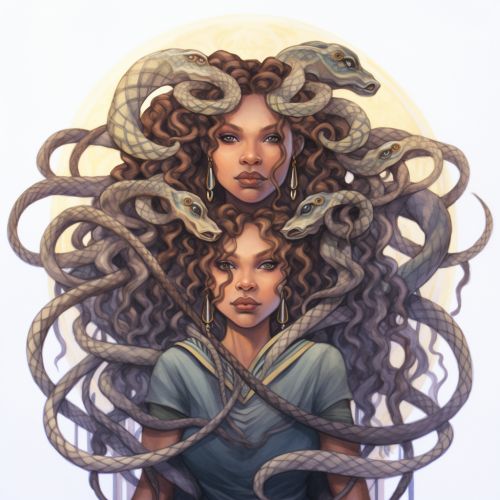Gorgons
Origins
The term "Gorgon" originates from ancient Greek mythology, where it was used to describe three monstrous sisters, namely Medusa, Stheno, and Euryale. The term itself is derived from the Greek word "gorgós," which translates to "dreadful." While descriptions of Gorgons vary across Greek literature, the standard depiction is that of winged female creatures with live venomous snakes in place of hair. Gorgons are renowned for their ability to turn onlookers into stone.


Characteristics
Gorgons are most commonly depicted as having the body of a woman, but with grotesque features that include fangs, brazen claws, and the aforementioned snakes for hair. They are often depicted with a belt made of two intertwined serpents that form a knot in the center, similar to the caduceus symbol. Gorgons are also commonly depicted with a girdle of serpents, wings, and the tusks of boars. Some ancient poets and mythographers describe the Gorgons as being born of monstrous form, while others suggest they were originally beautiful maidens who were transformed into their monstrous state.
Mythology
In Greek mythology, the Gorgons were daughters of the sea deities Phorcys and Ceto, who were among the offspring of the primordial sea god Pontus and his mother Gaia. The most famous of the Gorgon sisters is Medusa, the only one of the three who was mortal. According to the myth, Medusa was originally a beautiful maiden who was transformed into a Gorgon by the goddess Athena as punishment for desecrating her temple. Medusa's gaze was so terrifying that it could turn anyone who looked directly at her into stone. She was eventually beheaded by the hero Perseus, who used her severed head, which retained its petrifying power, as a weapon before giving it to Athena to place on her shield.
Cultural Impact
The image of the Gorgon has had a significant impact on Western culture and has been featured in a wide range of media, from ancient art to modern cinema. The Gorgon's image, particularly Medusa's, has been used in numerous works of art, including sculptures, mosaics, and paintings. In modern times, the Gorgon has been featured in literature, film, and television, often as a symbol of female rage or power.
